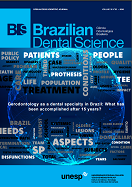Dental approach in unilateral osteoarthritis of temporomandibular joint: case report
DOI:
https://doi.org/10.14295/bds.2016.v19i2.1166Resumo
Objective: To describe a case of unilateral TMJ osteoarthritis from the Dentistry point of view, aiming to restore the quality of life through non-invasive procedures. Description of case: M.C.B., female, 69 years, complaining about a sudden change in the bite, difficulty to chewing/opening mouth and pain in the orofacial region. At extraoral examination, we observe the presence of crepitus in the left TMJ, click in the right TMJ (electrovibratography) and pain on palpation in the left TMJ region. Absence of tooth contacts on the right side in maximum habitual intercuspation (MHI). The intraoral examination revealed the presence of inflammation and excessive wear in the left mandibular condyle (osteoarthritis), visualized by computed tomography and magnetic resonance imaging with contrast. The patient underwent treatment by oclusal splint (night use), overlay removable partial dentures (daytime use), application of lower level laser therapy and transcutaneous electrical nervous stimulation (TENS). Masticatory function, mouth opening, and aesthetics improved. Conclusion: Conservative therapies may be a good option for the re-establishment of the quality of life in subjects with TMJ osteoarthritis, inasmuch as it can postpone or delete the indication of more invasive techniques (e.g. surgery).
Keywords
Osteoarthritis; Temporomandibular joint disorders; Temporomandibular joint.
Downloads
Downloads
Arquivos adicionais
Publicado
Como Citar
Edição
Seção
Licença
TRANSFERÊNCIA DE DIREITOS AUTORAIS E DECLARAÇÃO DE RESPONSABILIDADE
Toda a propriedade de direitos autorais do artigo "____________________________________________________________________" é transferido do autor(es) para a CIÊNCIA ODONTOLÓGICA BRASILEIRA, no caso do trabalho ser publicado. O artigo não foi publicado em outro lugar e não foi submetido simultaneamente para publicação em outra revista.
Vimos por meio deste, atestar que trabalho é original e não apresenta dados manipulados, fraude ou plágio. Fizemos contribuição científica significativa para o estudo e estamos cientes dos dados apresentados e de acordo com a versão final do artigo. Assumimos total responsabilidade pelos aspectos éticos do estudo.
Este texto deve ser impresso e assinado por todos os autores. A versão digitalizada deverá ser apresentada como arquivo suplementar durante o processo de submissão.




























